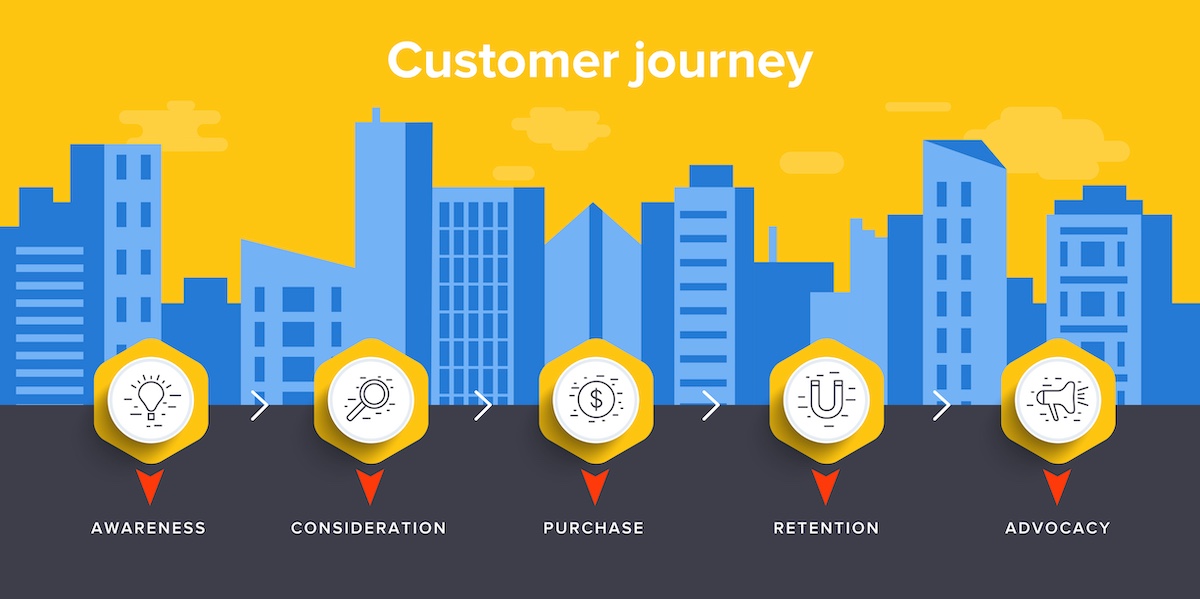Excellent customer service aims to anticipate and meet needs before customers are even aware of them. You want to create a seamless, personalized experience. And the best way to do that is to start with a customer journey map.
What is customer journey mapping?
Customer journey mapping is a visual representation of every experience customers have with you. It covers all channels (email, chat, online, in-person) and includes both positive and negative customer experiences. It tells the story of a customer’s journey across all phases, including:
- Awareness
- Consideration
- Decision
- Purchase
- Post-purchase
The goal is to more deeply understand your customers so that you can create a smoother, more enjoyable customer experience. This leads to enhanced customer satisfaction, increased loyalty, higher retention rates, and, ultimately, a better bottom line.
And it all starts with the customer journey map.
Steps in creating a customer journey map
So, how do you make one? Here’s a step-by-step guide to creating your own customer journey map:
Step #1: Identify customer personas and target customers
The first step is to name your typical customers. Make sure to include the following information:
- Demographic
- Buying behavior and history
- Goals and motivations
- Preferred channels of communication
- Pain points
The more detailed a customer persona is, the more helpful it will be. Personas allow you to understand who your customers are and what they want from your company.
Step #2: List all customer touchpoints and interactions
Write out all possible touchpoints across all possible channels. This should include your website, social media, email, customer service calls, and physical stores. Think about the customer’s perspective and include both pre- and post-purchase touchpoints.
Once you’ve listed out all of the experiences, identify the moments of truth. These points significantly impact the customer’s decision to continue or discontinue their journey. Moments of truth are critical opportunities to exceed customer expectations and gain loyalty.
Step #3: Segment according to customer persona
For each persona, map out the steps they take, from becoming aware of your brand to purchasing to returning for a repeat purchase. How might a middle-aged suburban mom interact with your brand differently than an urban businessman? Create separate lists to show the differences.
You’ll want to include details on how each persona interacts with your brand, their actions at each step, motivations, and any emotions or pain points they might experience.
Step #4: Create a visual representation of each buyer persona’s journey
Once you have written down each step of a typical customer’s journey, it’s time to design it. Turn the information into an easily readable visual representation (a.k.a. a map) for employees to reference and use.
Step #5: Analyze and share
Now it’s time to start using your map. Gather data from surveys, customer feedback, web analytics, and other sources and compare it to your journey map.
Does your map accurately show where customers tend to drop off? What are the most common places customers have positive and negative experiences? Use the journey map to pinpoint areas where you can enhance CX.
Don’t keep the information to yourself! Share the customer journey map with your marketing, sales, customer service, product development, and IT teams. Encourage employees to collaborate as they address pain points identified in the map.
Integrating customer journey mapping into CX strategies
An unused customer journey map does a company no good. It is essential to integrate your findings into effective CX strategies. Let’s take a closer look.
Align services with customer expectations:
The goal of the customer journey map is to understand customer expectations and align your services to meet them.
When you connect with a new customer, do they easily understand what your company offers? If not, consider adding a welcome sequence to your newsletter or clarifying the copy in your marketing materials. Do your customers tend to have remaining questions when deciding to purchase? If so, consider improving the information on your website or adding a chatbot service to answer questions 24/7.
As you gather information, refine your CX strategies to be more responsive to customer needs and expectations.
Design targeted improvements:
No company provides perfect service. You will undoubtedly find touchpoints that are causing friction and dissatisfaction. Don’t fret—this is helpful data.
Implement tailored strategies to solve these issues. Let’s say you’ve noticed a lot of churn during the consideration phase. Are potential customers choosing more highly-rated products over yours? Consider how you might incentivize product reviews from current customers.
Use insights from the customer journey map to anticipate potential issues and make it easy for customers to move through their journey with your brand.
Personalize the customer experience:
Use data from your customer journey map to personalize interactions at various touchpoints.
Think through your different customer personas and what each one would expect. Would they rather receive product instructions via email, on your website, and through a demo video? How might they prefer to get in contact with you when faced with an issue? Personalization makes customers feel valued and understood, significantly enhancing CX.
Leveraging data and analytics in customer journey mapping
Leveraging data and analytics in customer journey mapping involves collecting, analyzing, and applying insights from various data sources to understand and improve every stage of the customer’s interaction with your brand. This creates a more personalized and efficient customer experience. Here’s how you can do it:
Ready to perfect your CX?
Collect and analyze data across all touchpoints.
Integrate data collection tools across all customer interaction points, including your website, mobile app, social media, customer service channels, and in-store experiences.
Use cookies, tracking pixels, and analytics software to gather data on online behavior, as well as CRM systems for sales and customer service interactions.
As you collect customer data, regularly measure and analyze relevant KPIs. Use the following KPIs to assess the effectiveness of your CX strategies and identify areas for improvement:
- Customer satisfaction scores (CSAT) measures how pleased customers are with a specific experience or interaction. It’s typically obtained through surveys that ask customers to rate their satisfaction.
- Conversion rate is the number of users who take a desired action (like making a purchase) divided by the total number of visitors. This KPI is critical for understanding the effectiveness of the sales funnel.
- Churn rate is the rate at which customers stop doing business with a company. Monitoring churn helps companies understand how many customers they’re retaining over time.
- Retention rate: In contrast to churn rate, retention rate measures the percentage of customers who remain over a specific period. High retention rates usually indicate a positive customer journey and experience.
Use analytics to uncover insights
As you study the data, let it lead your CX decisions. Customize communications based on what you find compelling with your customers. Time special offers and promotions to re-engage customers on the cusp of leaving. Craft dynamic email and website content based on your customers’ past interactions and interests.
Predict future behaviors and preferences
None of us know the future, but businesses have a host of resources that help predict how customers are likely to behave. Here’s how to do it:
- Gather as much data as possible. The more data you have on customers’ past interactions, the better you will be able to predict future behavior.
- Implement machine learning and AI tools. Machine learning algorithms learn from data over time and improve their accuracy in predicting customer behavior. Many companies use algorithms such as decision trees, random forests, and neural networks. You can also use AI-driven tools to analyze unstructured data (like social media posts or customer support chat logs) for sentiment analysis and trend spotting.
- Use personalization engines that use customer data to predict and deliver personalized recommendations, content, and promotions in real time.
- Develop behavioral models that simulate different scenarios based on customer choices and interactions. This helps predict how customers might react to product, service, or policy changes.
The customer journey is not static; it evolves as customer behaviors and expectations change. Regularly update your customer journey map and integrate new insights into your CX strategies to ensure they remain relevant and effective.
Examples of effective customer journey maps
As we explore customer journey mapping, it is helpful to see tangible examples of how other companies effectively used the tool. Here are three case studies of organizations across industries that used customer journey mapping to improve customer satisfaction and drive business success:
1. Starbucks
Starbucks has long emphasized creating a personalized experience for its customers, offering seemingly endless variations to a cup of coffee. To further personalize its services, Starbucks used customer journey mapping to understand customer interactions from mobile app orders to in-store experiences.
By analyzing its customer journey map, Starbucks realized it needed to improve its mobile app. The company introduced the Mobile Order & Pay feature, which allows customers to order ahead and avoid waiting in line. This reduced wait times, increased sales, and strengthened customer loyalty.
2. IKEA
IKEA utilized customer journey mapping to understand their customers’ end-to-end experience, from online research to in-store visits to post-purchase support. This comprehensive mapping helped IKEA identify pain points in the shopping process. Customers were finding it hard to navigate their large stores and struggling to assemble furniture at home.
As a result, IKEA launched services to address these pain points. It added augmented reality features in its app so customers could visualize furniture in their homes and avoid going to the store altogether. IKEA also improved its online resources for assembly instructions. These initiatives led to an enhanced customer experience, increased in-store and online sales, and boosted overall customer satisfaction.
3. Bank of America
Bank of America used customer journey mapping to understand its customers’ digital banking experience better. It wanted to know when and how customers interacted with its online and mobile banking platforms.
To streamline transactions, the bank developed the Erica chatbot. This allowed them to provide 24/7 customer support. The bank also improved its mobile app’s user interface and functionality, making it easier for customers to manage accounts, monitor spending, and conduct transactions securely. These improvements lead to increased digital engagement, higher transaction volumes through mobile channels, and improved customer retention rates.
These case studies illustrate how effective customer journey mapping can improve customer satisfaction and drive positive business outcomes. By thoroughly understanding the customer experience at every touchpoint, organizations can make targeted improvements that not only meet but exceed customer expectations.
Customer Journey Outline
Stage 1: Awareness
- Touchpoints: Social media ads, word of mouth, Google search
- Customer Actions: Sees an advertisement on social media, searches for “best laptops 2024” on Google
- Emotions: Curiosity, interest
- Pain Points: Overwhelmed by choices
- Opportunities: Improve ad targeting; offer concise, helpful buying guides
Stage 2: Consideration
- Touchpoints: Website, product comparison pages, customer reviews
- Customer Actions: Visits the website, compares different laptop models, reads customer reviews
- Emotions: Interest, uncertainty
- Pain Points: Difficulty comparing features directly; some reviews lack detail
- Opportunities: Simplify comparison tool, incentivize detailed customer reviews
Stage 3: Decision
- Touchpoints: Shopping cart, checkout page, live chat support
- Customer Actions: Adds chosen laptop to cart, starts checkout process, uses live chat for last-minute questions
- Emotions: Confidence (with support), anxiety (about making the right choice)
- Pain Points: Concerns about warranty and return policy
- Opportunities: Clear, reassuring information on warranty and returns, streamline checkout process
Stage 4: Purchase
- Touchpoints: Payment gateway, confirmation email
- Customer Actions: Completes payment, receives order confirmation email
- Emotions: Satisfaction, anticipation
- Pain Points: Anxiety about order processing and shipping times
- Opportunities: Immediate and clear order confirmation, transparent shipping process updates
Stage 5: Post-Purchase
- Touchpoints: Delivery, product packaging, follow-up email, customer support
- Customer Actions: Receives and unboxes the laptop, setup, contacts support for a setup query, receives follow-up email asking for feedback
- Emotions: Delight (upon receiving), frustration (if setup issues), satisfaction (if issues are resolved quickly)
- Pain Points: Difficulty in initial setup, concern over needing support so soon
- Opportunities: Ensure easy setup with clear instructions, proactive customer support follow-up, solicit feedback to improve products/services
Opportunities for Overall Improvement
- Implement more personalized communication and recommendations based on browsing behavior.
- Increase visibility and accessibility of customer support across all stages.
- Enhance the post-purchase experience with loyalty programs or offers on future purchases.
Overcoming challenges in journey mapping
If customer journey mapping were easy, more companies would use it. However, properly understanding your customers’ experiences is challenging. It requires understanding customer behaviors, aligning internal processes, and leveraging data effectively. Here are five tips for tackling these challenges:
- Start with clear objectives: Define what you hope to achieve with your customer journey map. Whether it’s improving customer satisfaction, increasing conversions, or identifying pain points, having clear goals will help you focus your efforts and more easily measure success.
- Gather comprehensive data: One of the biggest challenges is ensuring accurate and comprehensive data. To get a full picture of the customer experience, use a mix of quantitative data (web analytics, sales data, customer service interactions) and qualitative data (customer interviews, surveys, feedback).
- Map multiple journeys: Recognize that not all customers follow the same path. Create different journey maps for different personas and for customers at various stages of their relationship with your brand to capture the full range of experiences.
- Identify moments of truth: Focus on the touchpoints that significantly impact customer decisions and satisfaction. Prioritizing these touchpoints can help you allocate resources more effectively to improve the customer experience.
- Keep the customer journey dynamic: Customer preferences and behaviors change over time, as do your products and services. Regularly update your journey maps to reflect these changes and ensure your customer experience strategies remain relevant.
Conclusion
Customer journey mapping is a powerful tool for enhancing customer satisfaction and driving business success. It allows you to serve your customers better, anticipate and meet their needs, and effectively address pain points.
Enhancing customer service is no small feat. Thankfully, our team at Global Response is dedicated to providing top-notch, personalized care. Contact Global Response today to see how we can partner with you to understand your customers more deeply and improve your CX.
FAQs
The main components of a customer journey map typically include:
- Customer personas: Detailed profiles of your target customer segments
- Stages of the journey: The key phases a customer goes through, from awareness to loyalty
- Customer touchpoints: The points of interaction between the customer and your business
- Customer thoughts and emotions: Insights into what the customer thinks and feels at each touchpoint
- Pain points and opportunities: Challenges customers face and opportunities for the business to improve the experience
We discuss this at length above, but here is a quick recap of how to start a customer journey map:
- Define your objectives for the journey map.
- Create customer personas based on research to represent your audience.
- Identify the stages of the customer journey.
- Map out all the touchpoints where customers interact with your brand.
- Collect data on customer thoughts, feelings, and behaviors at each touchpoint.
- Identify pain points and moments of delight.
- Analyze the map to find opportunities for improvement.
Yes, customer journey mapping is a versatile tool that can benefit businesses of all types and sizes. The specific touchpoints and customer interactions vary between businesses, but the core principle of mapping the customer journey to identify and address customer needs and pain points is universally applicable. Whether you’re selling products, providing a service, or operating in a niche market, understanding the customer journey helps improve the customer experience and boost your bottom line.




